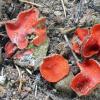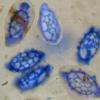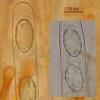
06-12-2025 00:19
 Viktorie Halasu
Viktorie Halasu
Hello, would anyone have this article, please? An

05-12-2025 17:33
 Bruno Coué
Bruno Coué
Bonjour, je serais heureux de recueillir votre avi

02-12-2025 18:59
This pair of ascos 2.5cm across were on recently b

02-12-2025 19:25
Buckwheat PeteHello, can anyone identify this hairy fungus growi

30-11-2025 12:53
 Edvin Johannesen
Edvin Johannesen
White short-stipitate apothecia found on thin twig

30-11-2025 10:47
 William Slosse
William Slosse
I recently found a collection of small Peziza sp.
Melastiza cornubiensis ou M. rubra ?
Nicolas VAN VOOREN,
30-06-2010 15:57
 On m'a confié une récolte d'un Melastiza (trouvé en très grand nombre sur un chemin forestier du Vercors). Voici les caractères micros principaux :
On m'a confié une récolte d'un Melastiza (trouvé en très grand nombre sur un chemin forestier du Vercors). Voici les caractères micros principaux :Asques 220-260 x 12-13 µm. Paraphyses à sommet ampullacé (6-11 µm), contenant un pigment orangé vif, très dense. Spores 14-15 (15.5) x (7.8) 8-9 µm, sans les ornements ; ces derniers sont constitués de crêtes hautes jusqu'à 2-2.5 µm, formant un réseau à mailles assez larges, et des pseudo-apicules en éperon ou hélicoïdaux, longs jusqu'à 4 µm. Poils marginaux bruns, bien visibles, à sommet obtus, cloisonnés, à paroi assez épaisse, longs jusqu'à 180 µm, pour 8-13 µm de large.
La taille relativement petite des spores (mesurées sur sporée) et l'ornementation m'incitent à aller vers Melastiza rubra plutôt que vers M. cornubiensis (= M. chateri). Qu'en pensez-vous ?
Nicolas VAN VOOREN,
30-06-2010 15:57
Edouard Evangelisti,
30-06-2010 16:03

Re:Melastiza cornubiensis ou M. rubra ?
Bonjour,
Les mesures des spores ont-elles été faites dans le bleu coton directement après montage ?
Cordialement,
Edouard
Les mesures des spores ont-elles été faites dans le bleu coton directement après montage ?
Cordialement,
Edouard
Nicolas VAN VOOREN,
30-06-2010 16:05

Re:Melastiza cornubiensis ou M. rubra ?
Les mesures ont été faites dans l'eau, avant le montage au bleu
Hans-Otto Baral,
30-06-2010 16:08

Re:Melastiza cornubiensis ou M. rubra ?
Hi Nicolas
I do not know A. rubra, anyhow I think I know A. cornubiensis quite well, and would much like to know the oil drop patter in the living submature spores. When fully ornamented this is not easily seen, but shortly before very well. In contrast, A. aurantia has always two big oil drops.
I do not know A. rubra, anyhow I think I know A. cornubiensis quite well, and would much like to know the oil drop patter in the living submature spores. When fully ornamented this is not easily seen, but shortly before very well. In contrast, A. aurantia has always two big oil drops.
Nicolas VAN VOOREN,
30-06-2010 16:37

Re:Melastiza cornubiensis ou M. rubra ?
I'm sure that the spores did not contain any "big" oil drop, and, as I can remember, the pattern was similar to your illustration.
René Dougoud,
02-07-2010 08:45
Re:Melastiza cornubiensis ou M. rubra ?
Cher Collègue,
Selon la description de Maas G. Les poils de M. rubra sont courts, jusqu'à 70 x 7-10 µm, jaunâtres, jaune-brunâtre à la marge. Les ascospores contiennent 2 grandes guttules. L'ornementation correspond à celle que tu montres. Maas indique, aux pôles, une hauteur de 2,7- 4 µm. Les espèces que tu indiques sont effectivement très proches !
Cordialement
René
Selon la description de Maas G. Les poils de M. rubra sont courts, jusqu'à 70 x 7-10 µm, jaunâtres, jaune-brunâtre à la marge. Les ascospores contiennent 2 grandes guttules. L'ornementation correspond à celle que tu montres. Maas indique, aux pôles, une hauteur de 2,7- 4 µm. Les espèces que tu indiques sont effectivement très proches !
Cordialement
René
Hans-Otto Baral,
02-07-2010 09:01

Re:Melastiza cornubiensis ou M. rubra ?
The original description by Batra (Mycologia 52: 525, 526) also says "a
scospores biguttulate":
http://www.cybertruffle.org.uk/cyberliber/
But the drawing shows not perfectly globose oil drops, so I assume they are drawn from dead spores. Therefore, it cannot be excluded that they were multiguttulate when alive.
Zotto
Zotto
scospores biguttulate":
http://www.cybertruffle.org.uk/cyberliber/
But the drawing shows not perfectly globose oil drops, so I assume they are drawn from dead spores. Therefore, it cannot be excluded that they were multiguttulate when alive.
Zotto
Zotto


